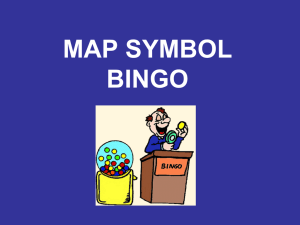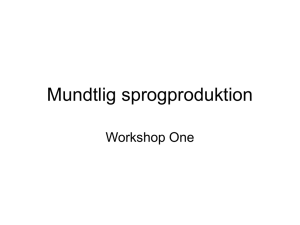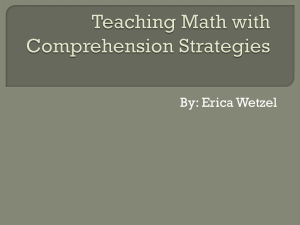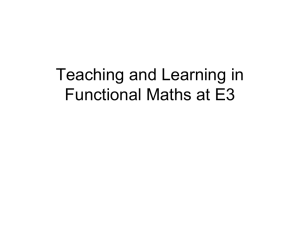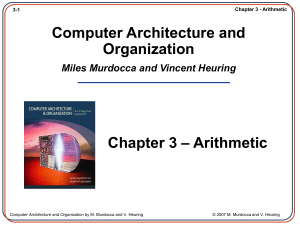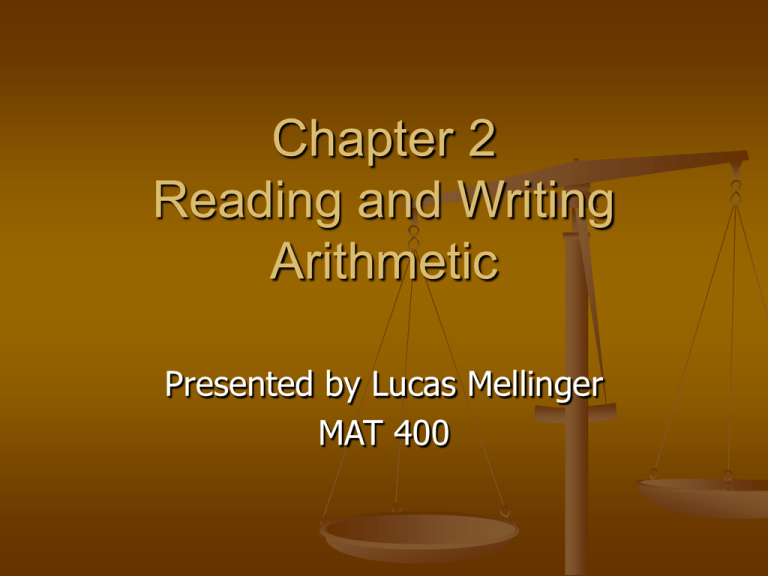
Chapter 2
Reading and Writing
Arithmetic
Presented by Lucas Mellinger
MAT 400
Activity
•
Write a solution to the following equation
without using any arithmetic symbols:
1½x + 4 = 10
One Possible Solution
•
“Calculate the excess of this 10 over 4.
The result is 6. You operate on 1½ to find
1. The result is 2/3. You take 2/3 of this 6.
The result is 4. Behold, 4 says it.”
- A’h-mose Moscow Mathematical Papyrus
Earliest Civilizations and
Mathematical Computations
•
•
•
Egypt and Mesopotamia
First dynasty ruled Upper and Lower Egypt
in 3100 BCE.
Algorithm vs. Theory
•
•
Egyptians used mathematics as a set of
instruction (architecture, agriculture,
commerce, etc.).
Greeks heavily stressed theory in their
mathematics.
Math in Ancient Egypt
•
Two papyri containing collections of
mathematical problems with their
solutions written by the scribe A’h-mose in
1650 BCE:
•
•
Rhind Mathematical Papyrus
Moscow Mathematical Papyrus
Math in Ancient Egypt
•
Addition and Subtraction:
•
•
Hieroglyphic Grouping
Multiplication and Division:
•
•
Doubling process expressed in a table
Example: multiply 12 by 13
‘1
2
‘4
‘8
12
24
48
96
Activity
•
Express the following without using any
arithmetic symbols:
(5+6) – 7 = 4
Possible Solutions
When 7 is subtracted from the
sum of 5 and 6, the result is 4.
•
•
From the ancient Greeks, through the middle
ages, until the early Renaissance, people wrote
out their problems and solutions in words.
Arithmetic symbols became more consistent with
the invention of movable-type printing.
Possible Solutions
•
•
•
1470’s
Written shorthand is the earliest form of
arithmetic symbols.
et is “and” in Latin
Possible Solutions
•
•
1489
Plus and minus signs are first used in a
commercial arithmetic book by Johannes
Widman:
+ was an abbreviation for “and”
- denoted a separation
•
“das ist” (German) means “that is”
Possible Solutions
•
•
•
1494
Symbols used in Luca Pacioli’s Summa de
Aritmetica.
Widely used throughout Europe
Possible Solutions
•
•
•
1557
First use of plus, minus, and equality symbols in
English text book The Whetstone of Witte by
Robert Recorde.
“No two things can be more equal” than parallel
lines of the same length.
Possible Solutions
(5+6)
•
•
7=4
1629
Widely used as subtraction in the 17th and 18th
centuries.
Possible Solutions
•
1631
•
Clavis Mathematicae by William Oughtred used
•
colons to emphasis a grouping of terms.
Also in the same year < and > were first used
as “less than” and “greater than.”
Possible Solutions
•
•
•
1637
Notation was used in Rene Descartes' La
Geometrie.
Used in Europe until the early 18th century.
History of Arithmetic Symbols
•
Early 1700’s – common notation emerged
due to the influential writings of Leibniz,
the Bernoullis, and Euler. The notation in
their writing has been used ever since,
and is now the most recognized
“language” of the world.
Other Important Dates
•
•
•
•
•
9th and 10th Centuries: Indian manuscripts first
began placing quantities to be multiplied next to
one another.
1356: Nicole d’ Oresme used a figure that looks
like our current plus and minus signs in a
manuscript called Algorismus Proportionum.
1417: Manuscript uses the plus symbol as the
abbreviation for the Latin “et.”
1600’s: X symbol appears for multiplication in
Europe
1698: Leibniz introduces the raised dot for
multiplication to avoid confusion between X and
the variable x
References
•
•
•
•
Berlinghoff and Gouvea
Cajori, Florian. A History of Mathematical
Notations. Dover Publications, New York,
1993. http://members.aol.com/jeff570/mathsym.html
Katz, Victor J., A History of Mathematics,
Pearson/ Addison Wesley, 2004
Parkinson, Claire L., Breakthroughs: a
chronology of great achievements in
science and mathematics, 1200-1930. G.
K. Hall, Boston, 1985.
Timeline for the progression of
arithmetic symbols
•
1650 BCE
•
BCE thru 1400’s
800 – 900’s
1400’s
•
1356
•
•
•
•
•
•
•
1417
1470’s
1489
1494
1557
Egyptian papyrus manuscripts containing a
collection of mathematical problems and their solutions.
Write out problems and solutions in words.
Placing quantities to be multiplied next to one another.
More consistency with mathematical terminology with
the invention of movable-type printing.
Possible use of current day plus and minus sign in a
manuscript by Nicole d’ Oresme.
Manuscript uses plus symbol as abbreviation for “et.”
Shorthand symbols commonly used to replace Latin
words.
First use of plus and minus signs in print.
“p” and “m” symbols used widely throughout Europe.
First use of plus, minus, and equality signs in an English
text book.
Timeline for the progression of
arithmetic symbols
•
•
•
•
•
•
1600’s
1629
1631
1637
1698
1700’s
X symbol appears for multiplication in Europe and German
manuscripts begin using * for multiplication.
Our current division sign appears as a minus sign.
Colons used to group terms in a mathematical equation.
Descartes uses odd new symbol for equality.
Leibniz introduces raised dot a symbol for multiplication.
Acceptance of our current mathematical symbols.





